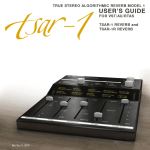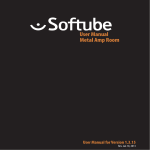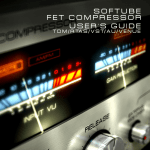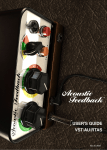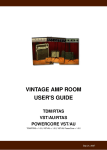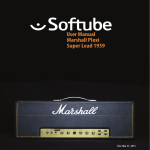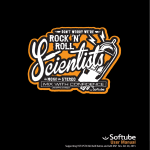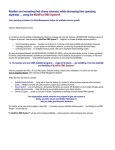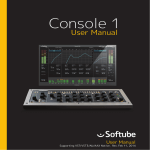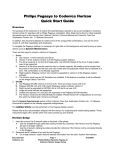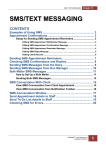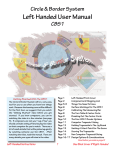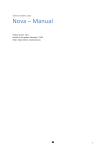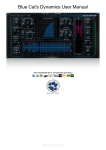Download Untitled
Transcript
2 Table of Contents Contact Details.............................................................................................. 4 Installation and Authorization.......................................................................5 Introduction................................................................................................... 7 About the Valley People Dyna-mite.............................................................. 8 User Interface................................................................................................ 9 Basic Limiting.............................................................................................. 10 Basic Expanding..........................................................................................11 Switches...................................................................................................... 12 Knobs...........................................................................................................14 Limiting Modes............................................................................................17 Expanding Modes........................................................................................22 Technical Stuff............................................................................................. 26 3 Contact Details If you would like to get in touch with Softube, please e-mail [email protected]. Alternatively, you could use the phone or send an old-fashioned mail (do you remember envelopes, stamps and paper?) to: Softube AB S:t Larsgatan 10c Web: www.softube.com E-mail: [email protected] SE-582 24 Linköping Sweden Phone: +46 13 21 1623 (9 am – 5 pm CET) Support On the Softube website (www.softube.com) you will find answers to common questions (FAQ) and other topics that might interest you. Support questions can be posted at http://www.softube.com, where we will help you as fast as we can! © 2010 SOFTUBE AB, SWEDEN. ALL PRODUCT AND COMPANY NAMES ARE TRADEMARKS OF THEIR RESPECTIVE OWNERS. SOFTUBE IS A REGISTERED TRADEMARK OF SOFTUBE AB, SWEDEN. ALL VISUAL AND AURAL REFERENCES TO THE VALLEY PEOPLE DYNA-MITE ARE TRADEMARKS BEING MADE WITH WRITTEN PERMISSION FROM PMI AUDIO. THE VALLEY PEOPLE, DYNA-MITE AND ASSOCIATED LOGOS ARE TRADEMARKS OF PMI AUDIO GROUP, USED UNDER LICENSE. ALL SPECIFICATIONS SUBJECT TO CHANGE WITHOUT NOTICE. ALL RIGHTS RESERVED. THIS SOFTUBE PRODUCT IS PROTECTED BY PATENT SE525332 AND PENDING PATENTS US20040258250, EP1492081 AND JP2004-183976. 4 Installation and Authorization IF YOU BOUGHT THE PRODUCT IN A BOX you will have to register it in order to transfer the license to your iLok account: 1. Go to http://www.softube.com/register to transfer the license to your iLok account. You will need the License Code found in the box, your iLok.com User ID, and your iLok USB dongle. Follow the instructions on the web page. and have got the confirmation e-mail, the license will already be deposited in your iLok account: IF YO U B OU GH T THE PRO DU CT ONL INE 2. Make sure that you have the latest iLok drivers installed. They can be found at http://www.ilok.com. 3. Log on to http://www.ilok.com and transfer the newly received license to your physical iLok dongle. 4. Install the software from the DVD, or download the latest version from http://www.softube.com/installers. Sometimes the DVD contains installers for all Softube products, but you will only be able to run those that you have acquired licenses for. In some cases, extra demo licenses are included when you buy a Softube product. 5 6 Introduction If you haven't used the Dyna-mite before, you will feel extremely confused. DON'T PANIC! As soon as you have acquainted yourself with the slightly weird layout and panel labels, you will learn how to master this powerful tool, and soon you will feel comfortable in knowing that you belong to the music industry's version of the “Trekkies”, ie., the Valley People fanatics. Take your time to look through the manual (start with the “Quick Overview” and “User Interface” to get acquainted with the normal modes of operation). During the learning period you will go through these steps: 1. Utter confusion. Desparation. Did I really pay for this? Solution: Read “Basic Limiting”, “Basic Expanding” and “User Interface”. It's just three pages. Listen to the sound examples on the Softube web site. 2. Pride. You have learned what the controls do. You think you master every aspect of it. Solution: Read the entire manual, as well as the manual for the original hardware (it's included on the CD). 3. Awe. You realize all the potential that is in this little thing, and start to think about all the cool things you can do with it. Solution: Do it! But don't despair. It doesn't take much time to learn how to use it, it's just that the first 15 minutes can be a bit confusing. Final word from the developers: Expanding is the new black! 7 About the Valley People Dyna-mite The Dyna-mite was designed for two main purposes: limiting and expanding. You select between limiting or expanding by setting the Mode switch (number 4 in the picture to the right) in either the L I M I T or E X P mode. Threshold (1), Release (2) and Output (7) works as in any limiter or expander. Range (6) is a nice addition that enables you to limit the maximum amount of gain reduction. On the Softube web site you can find sound examples that showcases some of the different things the Dyna-mite can do. All sound examples have an explanatory text and pictures of the settings so that you can try it out yourself. You can set the type of detector with the Detector Type (5) switch (the switch closest to the Range knob) . A V G is smoother and slower than P E A K . G A T E is a mode that works best in the E X P mode. With the Det Source (3) switch you select if you want to use the normal, internal, source (I N T ) or use an external side-chain (E X T ). With an external source you can do many fun things, including keying and ducking. You will always get a brief explanation about the current mode in the “Modes Display” beneath the unit. General Procedure: 1. Set Release to 0.05 (fully CCW), Range to 60 (fully CCW) and Output to 0 (12 o'clock) 2. Select your desired mode with the three switches, Detector Type, Detector Source and Mode. 3. Adjust Threshold so that the Gain Reduction Meter reacts differently on loud and silent passages. 4. Go back and adjust Release, Output and Range. Toggle Detector Type to get different attack times. In L I M I T mode, try switching between L I M I T and D S - F M modes. 8 User Interface 1) Threshold: Adjusts the level at which the Dyna-mite starts to expand or limit. 2) Release: Adjusts the time it takes to restore the gain after expansion/limiting. 3) Detector Source: Set it to I N T (normal operating mode) as a start. D S - F M and E X T are advanced modes. 4) Mode: Selects main mode. E X P =Expander/Gate, O U T =Bypass, L I M I T =Limiter. 5) Detector Type: Three different ways to detect the signal. Play around and try them out. 6) Range: Sets maximum amount of gain reduction. Advanced. Leave at 60 dB as a start. 7) Output: Sets output volume. Lower the volume if the output clips to much. A) Modes Display: Shows quick help and parameter values. B) Gain Reduction Meter: Displays the current amount of gain reduction. C) Clip LED: Lights up when the output signal is clipping. For more detailed explanations of each knob, please see the following chapters. 9 Basic Limiting Limiting is a hard Inf:1 ratio compression that can be used to increase the apparent volume, or to even out dynamic differences in a track. It works by reducing the gain for passages that are louder than the selected threshold. The limiting mode on the Dyna-mite is often used to squash drum tracks. Mode: L I M I T (limiting) Detector Source: I N T (internal source) Detector Type: A V G (slow attack) or P E A K (fast attack) Threshold: Adjust to set amount of limiting (as read from the G A I N Release: Adjust to set release time Range: 60 dB Output: 0—15 dB REDU CTI ON meter). Procedure 1. Set Threshold until you get the desired amount of limiting, as red on the LED array 2. Set the Output volume until you get the desired output volume. 3. Set the Release control by ear. If you get too much pumping, increase the release time. 4. Toggle the Detector Type between A V G and P E A K to get different attack times. 10 Basic Expanding Expanding is when you let the Dyna-mite reduce the gain for passages that are below the select threshold. You can use it as a soft noise gate, use it more aggressively as a hard guitar/drum gate, or you can use to expand the total dynamics of a track. Mode: E X P (expanding) Detector Source: I N T (internal source) Detector Type: A V G (slow attack), P E A K (fast attack), or G A T E (hard noise gate, fast attack) Threshold: Adjust to set the threshold of expansion Release: Adjust to set release time Range: 60—20 dB Output: –15—0 dB Procedure 1. Set the Release and Range to their min positions (CCW). 2. Adjust the Threshold so that the desired signals don't light up any LEDs (no gain reduction), while the undesired signals (noise) cause gain reduction (LED array lights up). 3. Set the Release control by ear: too fast release time can cause unwanted, abrupt, effects when the signal goes down below the Threshold. 4. Set the Range to get the desired amount of maximum attenuation. 5. Toggle the Detector Type (A V G , P E A K , G A T E ) to get different kinds of gating effects. 11 Switches Detector Source ( I N T, D S - F M , E X T ) Determines the source of the detector. INT: Internal source, normal operating mode for noise gating, expanding or limiting. The gain reduction circuit acts upon the same signal that is fed to the detector. EXT: External source, or “sidechaining”. The detector is fed a separate signal (a side-chain) and calculates the gain reduction from this signal. This gain reduction is then applied to the main signal. This is used for keying (side-chain expanding) and ducking (side-chain compression) modes. DS-FM (De-Essing and FM): Internal source, but with a detector filter that boosts the high frequencies, thus making it easier for high frequencies to trig the detector. This mode can be used for deessing, or it can be used rather creatively when increased sensitivity to high frequencies is desirable. All three switches work independently of each other, but don't be alarmed. Once you know what each switch does, the Dyna-mite will be easy to operate. 12 Mode ( E X P, O U T, L I M I T ) Determines if the Dyna-mite should expand or limit the sound. LIMIT: Limiting mode. Reduce gain for signals OUT: Bypass mode. Output volume knob and output EXP: Expander mode. Reduce gain for signals increasing above Threshold. stage clipping still active. below Threshold. Detector Type (GAT E, PEAK , AVG) This switch determines the ratio and attack times of the detector. AVG: A slower and more complex attack time (about 1– 15 ms). Inf:1 ratio in L I M I T mode, and 1:2 ratio in E X P modes (for soft noise gating). PEAK: Fast attack time (about 50 µs), useful for hard limiting of transient material. Inf:1 ratio in L I M I T mode, and 1:2 ratio in E X P modes (for soft noise gating). GATE: This is the most extreme mode. Fast attack time (about 50 µs). In L I M I T mode, the ratio is negative (1:–20), which means that for every dB above threshold, the output signal will be reduced by 20 dB! In E X P mode, you'll have a hard noise gate with a 1:20 ratio. So for every dB below the threshold, the signal will be reduced by another 19 dBs. Detector Type=G A T E can be confusing in the beginning, but you can see it this way: In E X P mode, the signal gets gated when the level drops below the threshold (that's normal). In L I M I T mode, the signal gets gated when the level goes above the threshold (that's weird). 13 Knobs Threshold Classic threshold control. Determines the signal level above which Limiting, or below which Expanding action begins. Variable from –40 dBv to +20 dBv, which in a plug-in translates to about –60 dBFS to 0 dBFS. A full scale (0 dBFS) sine wave, with Threshold set at max (+20 dBv), will cause the Dyna-mite to just start to limit or expand. The exact values depends on the mode selected. VCA Gain Coupling (a.k.a. Auto Make-Up Gain) In internal L I M I T and D S - F M modes, the Dyna-mite engages the VCA Gain Coupling which acts like an automatic make-up gain. Range This innovative control limits the maximum gain reduction. It varies from 0 dB (no gain reduction) to 60 dB possible gain reduction. This control is very useful when expanding, gating or keying. If you use the Keying mode ( E X T, E X P, A V G / P E A K ) to, for example, duck a background music score whenever a narrator speaks, you can set the Range control to 15 dB to prevent the music to be reduced by more than 15 dB. 14 In the original hardware, the Range control was only available in the E X P mode and left out in the L I M I T mode. This was probably due to implementation difficulties, so we decided to introduce the Range knob to the other modes as well. (To get the plug-in to behave exactly like the hardware, just set the Range knob back to 60 dB in the L I M I T modes.) Advanced: Range Knob in Limiting Mode (Zones) When limiting, the Range control gives you a very powerful tool to create a “zone” in which the limiting occurs. If you for example limit a drum track and the Gain Reduction meter reads 40 dB in the peaks, you can set the Range control to 25 dB and thus get three different zones: 1. No limiting when the drums are below –40 dB 2. Inf:1 limiting in the range –40 dB to –15 dB 3. No limiting for peaks exceeding –15 dB Since the peaks in the third zone would cause a gain reduction above the limit of 25 dB, and the Range is set at 25 dB, no further gain reduction will occur. The effect is that you have a very effective limiting in zone 2, but with the transients of zone 3 Anticipatory Release Computation being let through. It's different, but soundssomewhat similar to that of a parallel or “New York style” compression. Release Classic release time control. Determines the rate at which a gain is restored after Limiting or Ducking, as well as the rate at which gain is reduced after Gating, Keying or Expansion attacks. Variable from 50 ms to 5 sec/20dB. With fast release time settings and certain material, the gain reduction will follow the signal envelope too tightly, and “pumping” will occur. To escape these effects, yet still allow the user to select rapid release times, Valley International developed a proprietary circuit scheme known as Anticipatory Release Computation (ARC). It analyzes the program input and anticipate conditions which would cause either waveform gain modulation or excessively rapid pumping, and computes a different release envelope in order to prevent, or greatly diminish, these effects. Technical explanations apart, the ARC circuit is definitely a big part of the famous Dyna-mite sound. 15 Output Output volume control. Ranges from –15 dBv to +15 dBv. In limiting modes (L I M I T and D S - F M ), the output volume will be automatically corrected to fit with the chosen Threshold level. In all other modes, the Output volume will act as a simple gain control. You will soon find that this auto make-up feature is very handy, since it is extremely easy to make changes to the amount of limiting (with the Threshold control) without disturbing the balance of the mix. Clip Indicator The plug-in features an accurate model of the output stage in the hardware. So whenever the hardware would clip, the plug-in will as well. This is indicated by a Clip LED, and just as with the hardware, it is possible for the clip LED to flash, even with very heavy limiting, because the transients will in some cases slip through (for example in the A V G mode). The original manual states: “The clipping signal is [often] of exceedingly short duration, and is, in all probability, fully inaudible. Any decision to lower the output level because of sporadic flashing of the clip LED should be based upon what you hear. If the signal sounds “clean”, you are probably better off to leave the output level alone.” Times change, and today we often strive for a “dirtier” sound with distortion and clipping, so feel free to crank up the Output volume and experience the brutal distortion of the original Dyna-mite hardware... 16 Limiting Modes There are two basic limiting modes: the A V G and P E A K detection. On top of this, you can use the built-in pre-emphasis high frequency filter (Detector Source = D S - F M ) together with the internal signal. You can also use an external side chain to trigger the limiter (Detector Source = E X P ), which is usually called ducking. Finally, you can set the Detector Type to G A T E , which will give you negative limiting. In theory, the difference between A V G and P E A K lies basically in the way the detector calculates the envelope of the signal. A V G uses Linear Integration Detection, a proprietary method that Valley International developed, while P E A K uses a more traditional “log-ofthe-absolute-value” method. In practice, the differences lies in the timing. A V G is a bit slower, has a more natural sound, but can be tricky to work with. P E A K is faster and behaves more like a traditional limiter. You can always toggle between the P E A K and A V G modes and listen to the difference. 17 Classic Limiting Mode: L I M I T , Detector Type: A V G / P E A K , Detector Source: I N T Threshold: Adjust to material Release: Usually short, 0.05-0.5 sec Range: Typically 60 dB (see section about “Zones” for usage) Output: Adjust to material, typically above 0 dB. These are the classic limiting modes. If the detector is in P E A K mode, you will be able to raise the total volume more than in A V G mode, but the waveforms will be more distorted than in A V G mode. In A V G mode it is easier to get a more transparent limiting, but it is also easier to get lots of punch in a drum track since the slower attack time will let the transients through. The original manual recommends the A V G position except when you have very transient sounds. The limiter will let the fastest transients slip through, especially in A V G mode. These transients will be caught by the output clipping, and if they are very short in duration, the effect of the clipping will be inaudible. Level Limiting ( I N T, L I M I T, A V G ) Peak Limiting ( I N T, L I M I T, P E A K ) Ratio = Inf:1, Automatic make-up gain during limiting. Range control forced to 60 dB on hardware unit, but active in the plug-in. AVG mode is good for transparent limiting, or added punch to a bass line or drum track. mode is good for hard limiting, for example adding length to a snare drum sound or to limit fast transients. PEAK 18 De-Essing and Classic Limiting With Pre-Emphasis Filtering Mode: L I M I T , Detector Type: A V G / P E A K , Detector Source: D S - F M Threshold: Adjust to material, normally about 6—10 dB of gain reduction. Release: Usually short, 0.05-0.5 sec Range: Usually 60 dB Output: Adjust to material The D S - F M filter only boosts the high frequencies on the signal that enters the detector. The main signal (the one you can listen to) is not affected by this filter. This is a setting that's very useful for vocal de-essing, but also whenever you need to limit high frequency sounds (such as controlling cymbal levels). De-essing ( D S - F M , L I M I T, A V G ) Limiting High Frequency Sounds ( D S - F M , L I M I T, P E A K ) Ratio = Inf:1. Automatic make-up gain during limiting. High frequency EQ inserted in detector path. Range control forced to 60 dB on hardware unit. mode: Good for vocal de-essing. The original manual says: “It is important to note that the use of Linear Integration Detection [ie. the A V G mode] provides a much more effective mechanism for de-essing than does the conventionally used P E A K detection.” The reason for this is that the A V G mode's slower response time won't limit transient high frequency sounds (like a 't'), but will limit longer high frequency sounds (like in 'sss'). AVG mode: Good for drum track limiting, if you want to limit the cymbal sibliants. Setup a good limiting without using the D S - F M mode, and then toggle between I N T and D S - F M to hear which one you like the best. PEAK 19 Side-Chain Limiting/Ducking Mode: L I M I T , Detector Type: A V G / P E A K / G A T E , Detector Source: E X T Threshold: Setup the threshold level according to your side chain source level. Release: Tune by ear. Classic voice-over usually needs longer release times than ducking strings ducking under a 4/4 bass drum. Range: Use it! Set it to the desired maximum amount of ducking (in dB). The Range knob decides the Output: – maximum amount of possible A rather normal procedure is to let one track “duck” below another. For example ducking a synth pad by the strike of the bass drum (good use for the G A T E mode). Another classic example is using it to duck background music below a voice-over (good use for the A V G mode). ducking (in dB), so instead of fine tuning the Threshold to get the right amount of ducking you can fine tune the amount of ducking with the Range knob. Operating procedure (from the original manual): “In setting up for the Ducking operation, one would normally start with the Range at maximum (CCW) the Release time at minimum (CCW), and the Threshold at maximum (CW). After applying both signal sources, the Threshold would be adjusted such that a reliable full duck were achieved on each external signal passage. The operator [that's you!] would then adjust the Range control for the desired depth of duck, and the Release control for the desired recovery rate.” AVG/PEAK MODE: Inverse Envelope Follower ( E X T, L I M I T, A V G / P E A K ) Signal gain is determined by the level of the side chain signal. A 1 dB increase of the side chain signal level (over Threshold) causes a 1 dB decrease in signal gain. Using this in the A V G mode gives the “nicest” and “friendliest” ducking mode. mode gives a faster ducking that might crackle for some settings. 20 PEAK GATE MODE: Hard Ducking ( E X T, L I M I T, G A T E ) A 1 dB increase of the side chain signal level (over Threshold) causes a 20 dB decrease in signal gain. P E A K detection. Extreme ducking. Each time the side chain signal goes just a teeny bit above Threshold, the main signal will be almost entirely gated. Can be quite effective together with a limited gain reduction, as set by the Range knob. Weird Limiting Mode: L I M I T , Detector Type: G A T E , Detector Source: D S - F M or I N T In the category “Weird Limiting” we can find the negative ratio stuff. The negative limiting mode is a very special case, and is normally used together with longer release times and the Range control. In some settings, specifically with long release times and a Range at about 10–15 dB, you can get a very crackling sound. Increase the Range or the Release time to avoid this. Negative Limiting for "Organ Effects" ( I N T, L I M I T, G A T E ) Modified Negative Limiting ( D S - F M , L I M I T, G A T E ) Ratio = 1:-20. As input signal exceeds Threshold, a 1 dB increase causes a 20 dB decrease in output level. This is the mode that is the hardest to find some use for. It crackles and pops a lot, and one might suspect when reading the original manual that this is a mode that wasn't planned when designing the gear. More like “Wait, what happens if you use the gate together with the limiting mode? Ahh...” 21 Expanding Modes The expansion modes is operated in a very similar way to the limiting modes, with the big exception that it is, well, expanding rather than limiting. Another exception is that the G A T E mode actually gates the signal in the E X P mode, while it in the L I M I T mode acts like a negative ratio limiter. Classic Expansion/Noise Gating Mode: E X P , Detector Type: A V G / P E A K / G A T E , Detector Source: I N T / D S - F M Threshold: Adjust so that the desired sound levels extinguish all lights on the Gain Reduction LED array. Release: Start with minimum setting, and then adjust “by ear”. Range: Start with 60 dB, adjust to decrease the effect caused by the gating. Output: Usually below 0 dB In the classic noise gating mode you have three different settings of the Detector Type: A V G , P E A K and G A T E . The G A T E mode is the most brutal mode, and is pretty efficient to use on drums or heavy metal guitar if you want a more aggressive sound, but it should be regarded more as a creative tool rather than a problem solver. In all of these modes you can toggle between I N T and D S - F M to get different weighting of the frequencies. Setting the Detector Source in D S - F M mode will make the expander trig more easily on high frequencies, which can be a good thing if you for example are gating a drum beat and want to avoid gating the high frequency cymbals. Since noise often have a lots of high frequency content, you should set it to I N T if you want to do actual noise gating. But you probably want to use it more creatively anyway... 22 AVG MODE: Soft Noise Gating ( I N T / D S - F M , E X P, A V G ) Ratio = 1:2. A signal x dB below Threshold, will be attenuated another x dBs. The least obtrusive noise gate. Good for classic noise gating with sources that doesn't have strong transients (such as voice and strings). Use on slow to medium attack sounds. PEAK MODE: Soft Noise Gating with Faster Attack Time ( I N T / D S - F M , E X P, P E A K ) Ratio = 1:2. A signal x dB below Threshold, will be attenuated another x dBs. If the attack of the instrument is moderate to fast, such as with drums or certain types of guitar, it is better to use this P E A K mode. The faster attack time in P E A K mode assures that the gain is fully restored when the transient strikes. This mode can be pretty nice to use if you want to shorten the decay of a sound, such as a bass line or steel stringed acoustic guitar. With this mode you can get a standard Jazz Bass to sound like a damped Hofner string bass, or a steel stringed $3000 Martin to sound like a $30 banjo... Just set the Release time so that you get the right amount of decay. GATE MODE: Hard Noise Gating ( I N T / D S - F M , E X P, G A T E ) Ratio = 1:20, P E A K detection of input signal. A signal x dB below Threshold, will be attenuated another x dBs. Use it as a traditional, boring hard noise gate, or... use it to create hard hitting beats from almost any drum track! Set a short release time and aggressive gating, and set the Output volume high to get some distortion. Stack up many Dyna-mites with different amounts of distortion and release times to get fat snare and bass drum sounds... Toggle the D S - F M switch to include/exclude cymbals. 23 Keying Modes Mode: E X P , Detector Type: A V G / P E A K / G A T E , Detector Source: EXT While most people are accustomed to ducking, a.k.a side chain compression—for example ducking a synth pad when the bass drum strikes, the art of keying is still somewhat of a hidden secret for most people. I mean, how many times have you heard Oprah talk about the benefits of keying? Keying is when you let your main track (say a bass line) follow the envelope of the side chain track (for example a bass drum). So with this example, the bass line will be gated whenever the bass drum is silent, and whenever the bass drum strikes, so will the bass line. AVG MODE: Envelope Following Soft Keying ( E X T, E X P, A V G ) Signal gain is determined by the level of the side chain signal. A 1 dB increase of the side chain signal level (over Threshold) causes a 1 dB increase in signal gain. mode has (as usual) a more natural sound, but will slow down the attack of the main signal. Use when you don't need a fast attack time when opening the gate. AVG PEAK MODE: Envelope Following Soft Keying with Faster Attack ( E X T, E X P, P E A K ) Signal gain is determined by level of the side chain signal. A 1 dB increase of the side chain signal level (over Threshold) causes a 1 dB increase in signal gain. The extremely fast attack time will assure that the keyed signal has full gain when the attack of the side chain signal arrives, but this can sometimes cause the transient to “pop” or “crack” when the gate opens. This is usually not a problem if your mix consists of both the keyed and the side chain signal, since the real transient from the side chain signal will be audible at the same time as the (unwanted) “pop” sound. 24 GATE MODE: Hard Keying ( E X T, E X P, G A T E ) Signal gain is determined by level of the side chain signal. A 1 dB increase of the side chain signal level (over Threshold) causes a 20 dB increase in signal gain. P E A K detection. Same fast attack times as the Soft Keying mode with P E A K detection, but a much more aggressive on/off type of gate. Before the age of the DAW, it was very useful when you needed to tighten up poorly performed background vocals or horn sections. Use the player with the best timing as key, and use the Hard Keying mode on the other players to assure that all off-time notes are being gated. Today, it's just a cool effect. 25 Technical Stuff Key and Mouse Commands All numbers in the GUI are clickable. This allows you to easy select a setting by clicking on the wanted value. Hovering above a label will turn the mouse pointer into a pointing hand. Mouse UP/DOWN or MOUSE WHEEL (Mac only): Change a parameter, such as a knob or a switch. Keyboard Commands ⌘ (Mac) or Ctrl (Win), while changing the parameter value. FINE ADJUST: R E S E T T O D E FA U LT : Alt, while clicking on the knob or fader. Pro Tools Specific Keyboard Commands Ctrl+⌘/ÿ+Alt+click AUTOMATION CONTROL WIND OW : S HO W AU T O M AT IO N T R A C K: Ctrl+⌘/ÿ+click Mono and Stereo Operation The V A L L E Y P E O P L E D Y N A - M I T E plug-in is designed to work in both stereo and mono. How the different modes are selected depends on your host software. In most hosts you can select these when you select the plug-in. In other cases, inserting one the plug-in on a mono track will usually make it use the M O N O mode, while selecting it on a stereo track makes it use the S T E R E O mode. Inserting the Dyna-mite in Couple” mode. STEREO mode makes it behave just as the real unit in “Stereo Side Chain Operation Since side chaining isn't offically supported by the VST 2 format (the VST format used by most VST hosts), it might not work in your host. The plug-in will add two extra inputs 26 (inputs 3 and 4) and regards these as the external side chain input. System Requirements Supported sample rates: 44.1, 48, 88.2, 96, 176.4 and 192 kHz, in both mono and stereo. • Mac OS X (10.4 or higher) or Windows XP or higher • Mac: G4 or higher, Windows: PIII or higher • Any VST, AU or RTAS compatible host application • iLok USB key and the latest iLok drivers. • DVD drive or Internet access for installation Please, make sure that you always use the latest iLok driver. It is not included in the Softube installer, but can be downloaded from www.ilok.com. Buying Recommendations The V A L L E Y P E O P L E D Y N A - M I T E is a very cool and affordable hardware limiter/expander. Many people don't know how to use it and say they don't like it just because they cannot operate it. Once you've learned the plug-in you will have no problem at all to operate the real hardware, so if you find a unit—make sure you pick it up! (The thing on top of the unit is a description of all the different modes, the same texts that are displayed in our nifty little display.) 27 Valley People Dyna-mite plug-in was made by: Oscar Öberg – modeling, Niklas Odelholm – graphics programming. Torsten Gatu – framework programming. Arvid Rosén – modeling and framework programming. Ulf Ekelöf – 3D rendering. Original hardware was designed by Valley People Incorporated. © 2010 Softube AB, Sweden





























